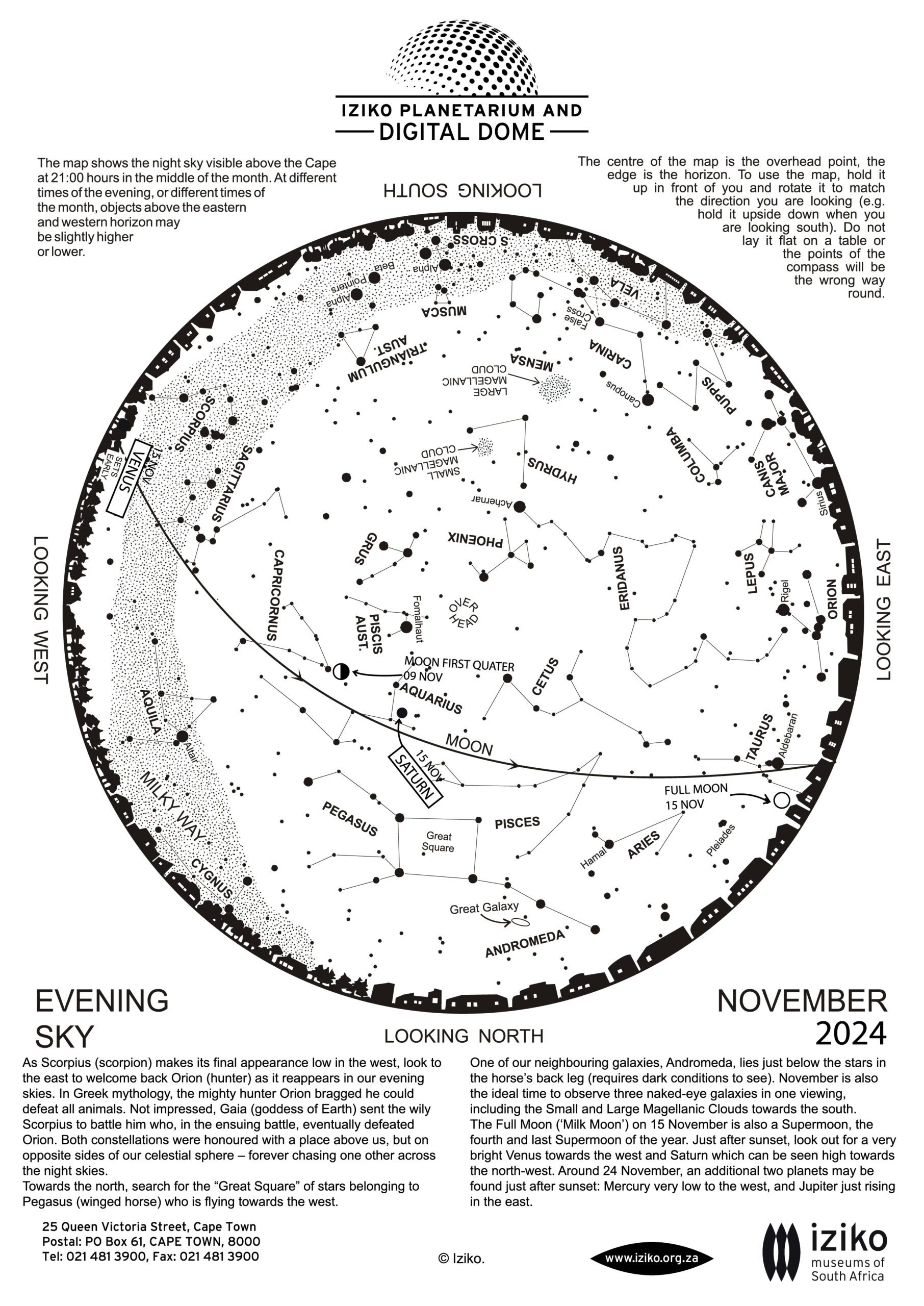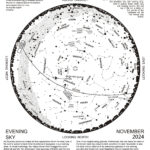
01 Nov Whats Up – November 2024
In a nutshell…
Moon
| Date | Time | Phase |
|---|---|---|
| 01/11 | 14h47 | New Moon |
| 09/11 | 07h56 | First Quarter |
| 15/11 | 23h29 | Full Moon |
| 23/11 | 03h28 | Last Quarter |
Moon – Earth Relations
Apogee: 405 315 km on 26/11 at 13h56
Perigee: 360 110 km on 14/11 at 13h18
Planet Visibility
Mercury is visible after sunset near the stars of the constellation Scorpius
Venus is visible after sunset near the stars of the constellation Sagittarius
Mars is visible near the stars of the constellation Cancer in the morning sky
Jupiter is visible near the stars of the constellation Taurus from late evening
Saturn is visible near the stars of the constellation Aquarius throughout most of the night
Some easy to identify bright stars
Rigel: blue supergiant in Orion
Betelgeuse: red supergiant in Orion
Procyon: yellowish white star in Canis Minor
Sirius: brightest star in the night sky, located in Canis Major
Antares: red supergiant in Scorpius
Arcturus: red giant in Boötes
Spica: brightest bluish-white star in Virgo
Canopus: yellowish-white star in Carina
Altair: a white star, brightest in Aquila
Regulus: blue–white star and the brightest star in Leo
The Pointers: Alpha and Beta Centauri
Sun and Moon
The New Moon occurs on the 1st of November at 14h47. The First Quarter falls on the 9th of November at 07h56. The Full Moon occurs on the 15th of November at 23h29 and the Third Quarter falls on the 23rd of November at 03h28.
The Moon will be at perigee (closest approach to the Earth) at a distance of 360 110 km on the 14th of November at 13h18. On the 26th of November at 13h56, the Moon will be at apogee (furthest from Earth) at a distance of 405 315 km.
Planetary and Other Events – Morning and Evening
This month’s night sky presents opportunities to observe 4 planets with your naked eye, namely Mercury, Venus, Jupiter and Saturn. Venus dazzles the sky as the bright Evening Star and is located near the stars of the constellation Sagittarius. Venus is near the Moon on the 5th of November. Mercury, the smallest planet within the solar system, is located near the stars of the constellation Scorpius and is visible in the early evening sky. Mercury will be at eastern elongation on the 16th of November and will be best positioned for observation then. Saturn is located high in the north near the stars of the constellation Aquarius. Saturn will be near the Moon on the 11th of November. Jupiter can be observed near the stars of the constellation Taurus. This giant planet will be near the Moon on the 17th of November. Mars is visible in the morning sky before sunrise and is located near the stars of Cancer. Mars will be near the Moon on the 20th of November.
Several meteor showers are visible in November: the Orionids, the Southern and Northern Taurids, the Leonids and the alpha-Monocerotids. The Orionids, which peaked in October, are active until the 7th of November. The Northern Taurids are active from the 20th of October until the 10th of December, with the peak rate on the 12th of November. The Southern Taurids are active from the 20th of September until the 20th of November, peaking on the 5th of November. The Leonids are active from the 6th to the 30th of November, peaking on the 17th of November. The alpha-Monocerotids are active from the 15th until the 25th of November peaking on the 21st.
To observe the alpha-Monocerotids, look east north-east near the constellation of Monoceros for the alpha-Monocerotids radiant (the area on the sky from which the meteors seem to originate). The best time to view the alpha Monocerotids is from around 23h00 to 04h00. They are very fast with some quite bright meteors. You should be able to see a few streaks an hour during the peak on the night of the 21st/22nd. To view the Taurids, look towards the constellation Taurus for the radiant. The best time to view the showers is from 21h30 to 03h30 on the nights of the 5th/6th (Southern) and 12th/13th (Northern) November. They are slow-moving meteor showers and at their peaks around 5 meteors per hour are predicted. To view the Leonids, look north-east towards the constellation Leo for the Leonids radiant. The best time to view the Leonids shower is from around 03h00 to 04h00. Around 10 streaks per hour are expected at the peak of the shower on the night of the 17/18th November.
The Evening Sky Stars
The stars of the Scorpion can still be glimpsed at the beginning of the month, low in the west after sunset, but only the tail is left by the end of November. Low in the northwest, the bright stars Vega and Deneb are likewise still visible on the 1st but gone by the 30th. November is a good month to look for the Great Square of Pegasus, visible moderately low in the northern evening sky all month. Below and to the right of the lower right-hand corner of the square is a double row of stars representing Andromeda (chained to a rock to appease a sea monster), and a dim fuzzy glow visible only on dark nights away from city lights. This is the Andromeda Galaxy, 2.5 million light years away and the most distant object easily visible to the unaided eye. Like our own Milky Way Galaxy, it’s a huge pinwheel of hundreds of thousands of millions of suns, more than a hundred thousand light years across. As galaxies go, it’s one of our near neighbours, and the largest in our local cluster. (Our Milky Way galaxy is the second largest.) The most distant galaxies we can see with telescopes are more than 12 thousand million light years away.
The bright star Altair still shines brightly among the stars of the Eagle in the northwest, and the bright stars of the Crane and the Southern Fish are almost overhead in early evening. The foggy glow of the Large and Small Magellanic Clouds can easily be seen in the south (on dark nights away from city lights), with bright Achernar quite near the Small Cloud. Canopus (second brightest star in the night sky) is rising in the southeast in early evening, while the Southern Cross and the Pointers are sinking lower in the southwest. The Milky Way is less well placed in November evenings than earlier in the year, low in the western and southern sky.
Rising in the east on November evenings are the stars of summer, with the bright stars of Taurus the Bull, Orion the Hunter and his dogs glowing brightly in the east. The brightest star in our night sky is Sirius, the ‘eye’ of the Large Dog, and it often twinkles spectacularly near the horizon, sometimes appearing to flash red and green and producing UFO reports from members of the public who don’t watch the sky often.
The Morning Sky Stars
Regulus can be spotted at the end of Leo the Lion in the NE before dawn, while low in the north are the stars of the Twins, with brilliant Capella just above the horizon in the NNW. A bit higher in the north (above the twins) is Procyon, the brightest star in Orion’s smaller hunting dog. Orion himself is to the west of Procyon (left if you are facing north), holding up his club and lion skin while the Bull charges him from the west. Since Orion, like the other constellations invented in the northern hemisphere, is upside down in our skies, the Large Dog naturally runs above his feet. The stars of the Large Dog include Sirius, which appears brighter to the eye than any other star in our night sky. Only 4 stellar systems are closer to the Sun than Sirius (8.6 light years), and it is by far the brightest of the stars in our neighbourhood, giving off more than 20 times as much light as our own Sun. The overwhelming majority of the stars nearest to our Sun are so dim that a telescope is needed to see them despite their closeness. Most of the stars we see in the sky with the naked eye are the rare extremely bright stars that can be seen at great distances.
High in the south are the bright stars of the great ship Argo. Brightest of these is Canopus, second brightest star in Earth’s night sky and nearly overhead. Canopus is 15000 times as bright as our own sun, a rare supergiant which is the brightest star within 700 light years of us. If Canopus were at the same distance as Sirius it would rival the first quarter moon in brightness, and the southern hemisphere sky would seldom be fully dark! If this supergiant star were in the sun’s place at the centre of our solar system, its surface would lie three quarters of the way out to Mercury’s orbit, and a planet with an earth-like temperature would have to be three times as far out as Pluto.
Achernar and the Small Magellanic Cloud are sinking into the southwest in the sky before sunrise, while the Cross and the Pointers (the two brightest stars in Centaurus) are rising in the southeast. Just above the Southern Cross and the Housefly are the stars of the great ship Argo as it sails along the Milky Way, accompanied by the dim stars of the Flying Fish. The Milky Way stretches across the sky from the southeast to the northwest, passing almost overhead, but the northern portion is fairly dim and rather smooth looking, while the southern part is much brighter with obvious dark patches. When we look toward the Keel of Argo, we look directly along our own spiral arm in our galaxy, and the greater abundance of stars in that direction makes this a bright patch in the Milky Way. To the south and east of the Keel we look inward toward the richer star fields of the inner galaxy; to the north and west we look through the less impressive outer regions of the galaxy, where there are fewer stars.
Sivuyile Manxoyi
sivuyile@saao.ac.za
X: @rassivuyile
The evening sky over Cape Town
The evening sky over Johannesburg


